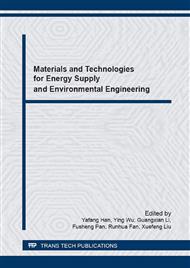[1]
S.Y. Li, W.H. Ma, Y. Zhou, Influence of fabrication parameter on the nanostructure and photoluminescence of highly doped p-porous silicon, J. Lumin. 146(2014) 76-82.
DOI: 10.1016/j.jlumin.2013.09.024
Google Scholar
[2]
S.Y. Li, W.H. Ma, Y. Zhou, et al. 3-aminopropyltriethoxysilanes modified porous silicon as a voltammetric sensor for determination of silver ion, Int. J. Electrochem. Sci. 8(2013) 1802-1812.
DOI: 10.1016/s1452-3981(23)14266-0
Google Scholar
[3]
H. -J. Kim, Y. -Y. Kim, K. -W. Lee, H. Cheng, and H. Dong Han, Porous silicon layer for optical sensing of organic vapor, Physica B: Condensed Matter, 406(2011) 1536-1541.
DOI: 10.1016/j.physb.2011.01.064
Google Scholar
[4]
D. J. Guo, S. J. Xiao, B. Xia, W. Shuai, J. Pei, Y. Pan, X. Z. You, Z. Z. Gu, and Z. H. Lu, Reaction of porous silicon with both end-functionalized organic compounds bearing omega-bromo and omega-carboxy groups for immobilization of biomolecules, Journal Of Physical Chemistry B, 109(2005).
DOI: 10.1021/jp0535689
Google Scholar
[5]
L. Chen, Z. -T. Chen, J. Wang, S. -J. Xiao, Z. -H. Lu, Z. -Z. Gu, L. Kang, J. Chen, P. -H. Wu, Y. -C. Tang, and J. -N. Liu, Gel-pad microarrays templated by patterned porous silicon for dual-mode detection of proteins, Lab on a Chip, 9 (2009).
DOI: 10.1039/b821265a
Google Scholar
[6]
J. Y. Lee, W. K. Han, and J. H. Lee, Effect of ultrasonic frequency on electrochemical Si etching in porous Si layer transfer process for thin film solar cell fabrication, Solar Energy Materials and Solar Cells, 95(2011) 77-80.
DOI: 10.1016/j.solmat.2010.04.058
Google Scholar
[7]
É. Vázsonyi, E. Szilágyi, P. Petrik, et al. Porous silicon formation by stain etching, Thin Solid Films, 388(2001) 295-302.
DOI: 10.1016/s0040-6090(00)01816-2
Google Scholar
[8]
X. Li, P. Bohn. et al . Metal-assisted chemical etching in HF/H2O2 produces porous silicon, J. Applied Physics Letters, 77(2000) 2572-2574.
DOI: 10.1063/1.1319191
Google Scholar
[9]
Y. Qu, L. Liao, Y. Li, H. Zhang, Y. Huang, and X. Duan, Electrically Conductive and Optically Active Porous Silicon Nanowires, Nano Letters, 9(2009) 4539-4543.
DOI: 10.1021/nl903030h
Google Scholar
[10]
S.Y. Li, W.H. Ma, Y. Zhou, et al. Fabrication of porous silicon nanowires by MACE method in HF/H2O2/AgNO3 system at room temperature, J. Nanoscale Res. Lett. 9 (2014) 196-203.
DOI: 10.1186/1556-276x-9-196
Google Scholar
[11]
L. Volker, et al, Electrochemistry of Silicon: Instrumentation, Science, Materials and Applications, J. wiley VCH, 2002, p.24, 79, 52, 162.
Google Scholar
[12]
Z. R. Smith, R. L. Smith, and S. D. Collins, Mechanism of nanowire formation in metal assisted chemical etching, Electrochimica Acta, 92(2013) 139-147.
DOI: 10.1016/j.electacta.2012.12.075
Google Scholar
[13]
K. Peng, A. Lu, R. Zhang, and S. -T. Lee, Motility of Metal Nanoparticles in Silicon and Induced Anisotropic Silicon Etching, Advanced Functional Materials, 18(2008) 3026-3035.
DOI: 10.1002/adfm.200800371
Google Scholar
[14]
K. Tsujino and M. Matsumura, Morphology of nanoholes formed in silicon by wet etching in solutions containing HF and H2O2 at different concentrations using silver nanoparticles as catalysts, Electrochimica Acta, 53(2007) 28-34.
DOI: 10.1016/j.electacta.2007.01.035
Google Scholar


